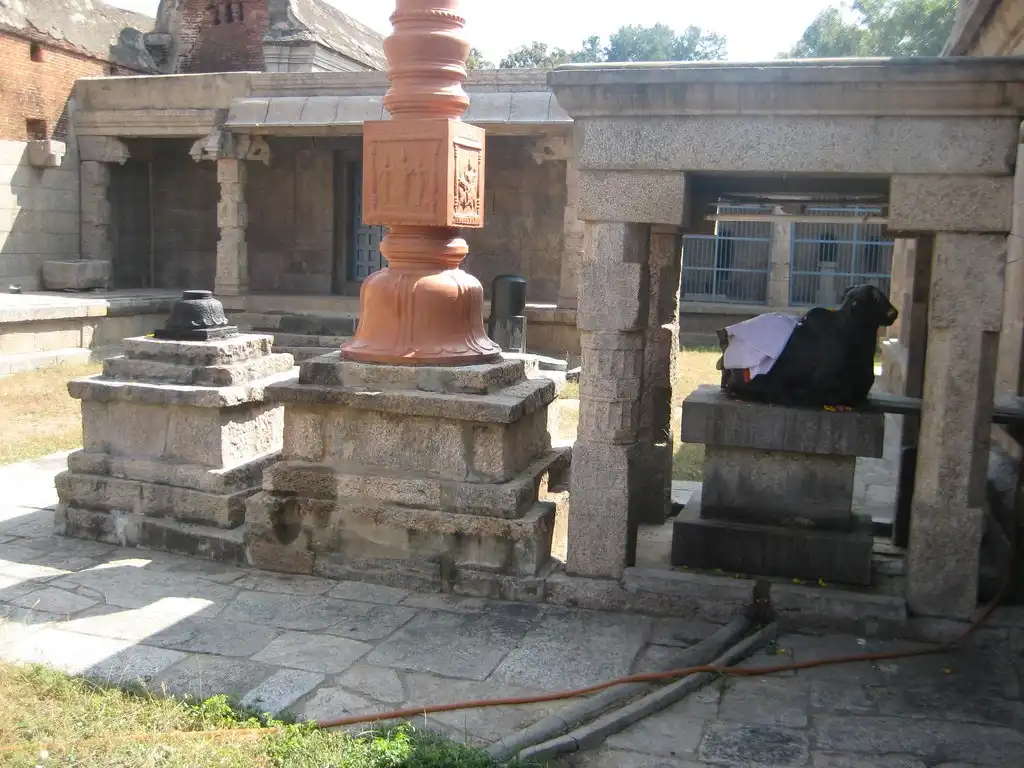Balipeetham is one of the most misunderstood elements of Indian temple architecture. It is a small square or octagonal structure built on a raised square platform. Depending on the temple, the Balipeetham can feature intricate designs or maintain a simple appearance. It is typically positioned near the Dhwajastambha (flagstaff).
A common misconception about Balipeetham is that it was intended for animal sacrifices—an idea largely propagated during British rule. While the concepts of “sacrifice” and “animal sacrifice” are often associated with Balipeetham, their meanings and purposes are fundamentally different.
ALSO READ: Dhanvantari: The Divine Healer and God of Ayurveda
The term “Bali” carries two distinct meanings—”powerful” and “sacrifice.” As a result, Balipeetham (seat or place of Bali) can be interpreted as either the “seat of the powerful” or the “place of sacrifice.” Contrary to popular belief, the Balipeetham was not intended for animal sacrifices; however, it did have a connection to animals.
Balipeetham: A Symbol of Offering, Ecology, and the Legacy of King Mahabali
Instead of being used for sacrifice, the Balipeetham served a more ecological purpose—it was a place where animals were fed. Devotees visiting the temple would bring food offerings, which were first dedicated to the deity at the Balipeetham and later distributed to animals. This practice symbolized a powerful (Bali) individual making an offering (sacrifice) to the divine.

The food offering, known as Naivedyam, is first presented to the deities. After the offering is made, the Naivedyam is placed at the Balipeetham, where it is consumed by the surrounding birds and animals. In this way, the Balipeetham serves as a means for the powerful to provide sustenance to animals, which can metaphorically be seen as an act of sacrifice.
Additionally, after completing the rituals inside the Garbhagriha (sanctum sanctorum), the temple priest applies a portion of the Prasad to the Balipeetham as part of the tradition.
The Balipeetham is closely associated with a well-known folktale—the legend of Mahabali, one of the greatest rulers in history, whose story is recounted in various epics and Puranic texts. Mahabali was a descendant of the sage Kashyapa and the grandson of the devoted Prahlada. Renowned for transforming his kingdom into a paradise, he is celebrated as a virtuous and immensely successful monarch.
The Legend of Mahabali
In Kerala, Mahabali’s legend is central to the grand celebration of the Onam festival. In other states such as Maharashtra, Karnataka, Gujarat, Telangana, and Andhra Pradesh, he is honored during festivals like Balipratipada, Balipadyami, or Bali Padwa, which marks the first day of the Kartika month and the third day of Deepavali.
Mahabali’s reign was so prosperous and just that it stirred the envy of Indra, the king of the heavens, who sought Lord Vishnu’s intervention to end his rule.

Lord Vishnu assumed the form of Vamana, a small Brahmin dwarf, to intervene in Mahabali’s reign. During a grand Ashvamedha sacrifice held by Mahabali to celebrate his victories, Vamana approached the king and humbly requested “three paces of land” as a gift. Despite the warnings of his advisor Shukra, who recognized Vamana’s true identity, Mahabali honored his promise and granted the request.
In an astonishing turn of events, Vamana expanded into his cosmic Trivikrama form. With his first step, he covered the entire heavens, and with his second, he spanned the earth. Left with no place for the promised third step, the noble king, accepting his fate, humbly offered his own head for Vishnu to place his foot upon.
Varied Traditions and the Divine Boon of Balipeetham
Different Hindu traditions offer varying accounts of Mahabali’s fate after his encounter with Vamana. Some believe that he was sent to the netherworld (Patala), while others suggest that Garuda carried him there. Another version of the story states that Lord Vishnu, by touching him, granted him entry into paradise.
Some traditions hold that Mahabali was blessed with Chiranjivi status, making him immortal. While others believe that he was granted access to Vaikunta, a realm even higher than the dominion of the devas.
According to one version of the legend, Lord Vishnu, moved by Mahabali’s immense sacrifice, offered him a boon. In response, Mahabali requested a place close to the divine presence. Granting his wish, Vishnu bestowed upon him a seat (Peetham) within every temple. Which came to be known as the “Seat of Mahabali” or Balipeetham.

A Sacred Seat for Compassion and Spiritual Cleansing
In honor of the great king’s benevolent spirit, it is at this sacred spot that devotees place Prasad. Ensuring that animals are also cared for and fed, reflecting Mahabali’s compassionate values.
The Balipeetham also holds deep spiritual and psychological significance. In Hindu philosophy, it is believed that individuals are plagued by six inner enemies of the mind, known as Shadripu. These include matsarya (envy), mada (ego or pride), lobha (greed), krodha (anger), kama (desire), and moha (attachment). When devotees visit the temple, they are expected to free themselves from these negative traits.
This is where the Balipeetham plays a crucial role. It is regarded as the seat of offering, where worshippers symbolically surrender these six impurities to the deity before stepping into the temple with a purified mind. In this way, the Balipeetham serves as a means of mental and spiritual cleansing.

